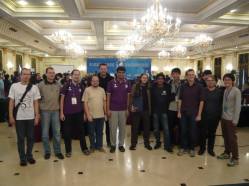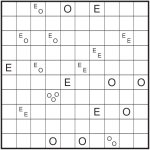WSC Preliminary aftermath
Since there were just 3 rounds on Day 2, the Play-offs could happen soon after, with a lunch break in between. As of this point, we still did not know the results and I was still wondering if I’d done enough in the last 3 rounds to reach the top 20. We were hoping Rohan would make the play-offs but he didn’t have a great last 3 rounds, his expected scores made that really improbable, with it being more likely he’d dip from 12th. As it turns out, that was exactly the case when we saw the results, and I had made no mistakes, to take me higher than I expected at any point after Day 1’s disappointment. I finished 15th, and Rohan finished 16th. Great for the team to have two in the top 20, but it would’ve been nicer with 3. Unfortunately Rishi had some health problems coming into Day 2, and really fell backwards in the rankings. He ended 28th. Jaipal stayed consistently around the late 50s, and finished 58th.
In the aftermath, there were some really funny scores given, as the checkers were probably in a hurry to get the play-off relevant results up quickly, and didn’t pay as much attention to the rest. A few notable scores displayed on the score page were, Fred Stalder getting 15 for a round where he’d actually scored 154, David Jones getting 34 (I think) where he’d actually scored 340+, and the best one of all, Helen Arnold getting 774 for a round where she’d scored 74, pushing her from 102nd to 50th or something, till the changes were made. There’s a tragic story of how she fought valiantly for the points before losing them, but thats for another day.
WSC Playoffs
The Semi-finals involved the top 10 sitting in a row of 10 tables, with the first ranked player after the preliminaries getting a time advantage over 2nd, and so on. As they went forward, the rows had lesser tables, and thus players would get eliminated until they had 3 quickest solvers. Tiit Vunk was a runaway leader after the Preliminaries and had a 5 minute advantage. Bastien Vial-Jaime was at 2nd place. They both got through the first table fine. The second table, I’m told, had a Killer Sudoku. Here, both of them reached a complete standstill. In the meantime, the rest of the field managed to solve the Killer and move on, meaning that the top 2 seeds were immediately knocked out.
Fast forward a little, and the Semi-final was finished first by Kota Morinishi, ensuring him a place in the finals and a chance to choose 3 out of the 5 Sudokus that would be used for the 1-on-1 final. Jin Ce was the 2nd one to finish the semi-finals, followed by an injured Jakub Ondroušek (he had hurt his foot before even arriving for the WSC, and was in some protective gear and crutches) to complete the podium.
There would now be the finals between Kota and Jin. I have a bit of a hazy memory of all things until it was 2-2. For the last Sudoku, Kota had chosen a Medium (?) Classic. I don’t know what was left in the pool, but it seemed to be playing to Jin’s strengths (not that Kota is any slouch in Classics). It was quite a dramatic finish, with Kota finishing mere seconds after Jin, and then both having to wait for confirmation that they had solved correctly. Turns out both had, and Jin Ce was crowned the new World Champion.
WSC Aftermath
Right after this, I assembled the folks of the Daily League on facebook, and we had a group photo, with almost all the authors in order from Monday to Sunday (Stefan was out of place, he should be Thursday with Rishi). See for yourself. We have, from left to right, Monday (Tiit Vunk, Christoph Seeliger, Jakub Hrazdira, Fred Stalder), Out-of-Place-Thursday (Stefan Heine), Tuesday (me), Wednesday (Bastien Vial-Jaime), Thursday (Rishi Puri, Sinchai Rungsangrattanakul), Friday (Tom Collyer), Saturday (Bram de Laat), Sunday (Seungjae Kwak).

.
.
.
.
.
.
Then, we had the traditional underground puzzle racing start up, with the Japanese team taking part. We had Jason, the undisputed Kakuro Champion, and a bunch of Nikoli legends disputing that, with Byron on commentary and quite an audience. At one point I believe this had more audience than the Champion’s press conference. Obviously, the underground racing is a big deal 😛
I skipped the Mahjong game session for reasons I have now forgotten. Oh right, I think I was late, it had already started, so I went exploring… Moving on then, to the WPC doubt solving session. This was nice as the 4 author teams of the Around the World in 80 Puzzles rounds were called up to manage their own rounds. So it was Bram for Dutch Delight, me for Indian Intrigue, Thomas for Doubled Decathlon and Cedomir for Serbian Snacks, each answering questions about our respective rounds. The teams other than the author teams were given a table where they were to mark the round each teammate would skip. The question of the night came from Ulrich Voigt, asking if he could skip the Digital Round if he solved all 4 of these rounds! Anyway, onward to the next morning, the start of the WPC.
WPC Day 1
Round 1 : Welcome to China (Team Round) – 60 minutes
This round made use of rotating tables. Eight puzzles were close to the solver on the stationary part of the table, with each having 13 rows and 10 columns. Then there were eight grids of 7 rows and 10 columns on the rotating part, and solvers must match the two parts to solve 8 complete grids. The puzzles were in two groups of four: four region types, and four black/white circle types. This round was really fun and had a “Welcome” message with either the region or the circles making a letter in each grid.
I took the Double Back and the Masyu. The Masyu had a lot solved in the bottom itself. The Double Back was slower going and I had to wait for certain eliminations. But once I had the top, the Double Back solved smoothly and was an excellent puzzle. I had 2 possible top halves for the Masyu, so I then went to check on the others. Different Neighbours (Only 4 Digits) was done successfully, I think by Rohan, We also had the Corridors solved fine by Amit, and Star Battle finished, either by Rohan or Rajesh (I think Rajesh). Rajesh was finishing the Binaire, Rohan had moved to the LITS where Amit was stuck, and Amit had moved to the Yin Yang. So I first went over to check the LITS which Rohan had finished, and found an error. Thankfully he had a clear marking of the area from where he’d guessed, so we erased that much, and I was able to solve it while Rohan went over to help with the Yin Yang. I then went to check other grids, and reached the Binaire which Rajesh had finished by then. Again, I spotted an error. This error was only in the top half of 7 rows, and since it is a mainly row-constrained puzzle type, we took a shot and just erased the top and re-did it. It solved fine thankfully.
Now what was left were the Yin Yang and the Masyu. With time running out, we just made a guess on which was which, because both worked for Masyu, and no one on the team was strong enough at Yin Yang to spot the deduction that may have been needed. I quickly solved the Masyu with that top half. It may have been wrong, or we made a mistake in the Yin Yang. Either way, the Yin Yang just would not get solved, even with all four of us looking at it towards the end. Thankfully we get points for correctly solved grids even if the piece might have belonged to another puzzle for the ideal overall solution.
Score – 1750/2000.
Round 2 – Classic Puzzles (Individual Round) – 90 minutes.
This was a round filled with common puzzle types. Everything seemed normal except for the existence of a Sudoku +/-4 (which is the reason for my practice-turned-league-post yesterday). No complaints from here though. It is a nice variant, I like math variants, and I was looking forward to getting to it. Unfortunately, I never got to it except for the last 3 minutes, when I decided it’d be less of a risk to go back and try to fix the Radar puzzle I’d broken along the way. I succeeded in that, so I feel it was a smart choice. The highlight of this round, at least for me, was the Yajilin. It had all 0 clues, and had a constraint that forced in a whole lot of black cells. I didn’t see this constraint during competition but figured intuitively that that was the way to go. I got out 13 of the 16 puzzles in this round. Even though the 3 I missed (2 Domino Halves and the Sudoku) I felt pretty good about it. Score – 440/600.
Round 3 – Digital Puzzles (Individual Round) – 40 minutes.
Bad. Good puzzles, the ones I solved at least, but this went really bad for me. I got 4 puzzles done out of 9, and missed out on the Digital Price Tags, a high pointer, after coming really close. I later heard that the other big pointers were probably overvalued, but I haven’t checked them yet, so I can’t comment on that. Score – 140/400.
The next one will cover the rest of the WPC, including my own round, Indian Intrigue, and also why my finger seems to be more famous than my WPC performance right now.







